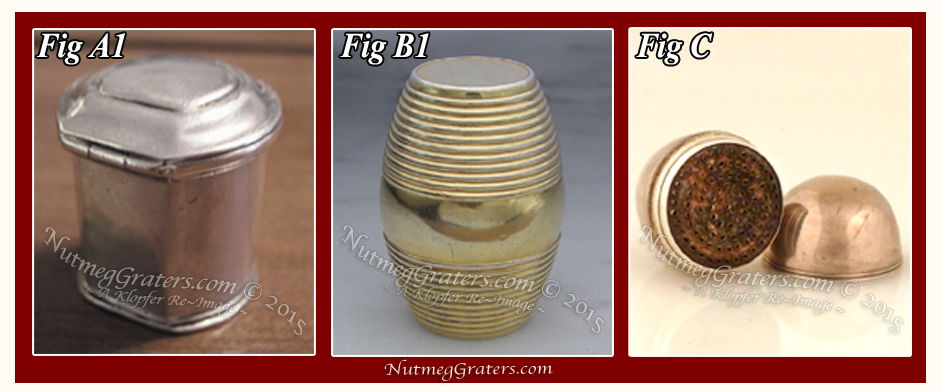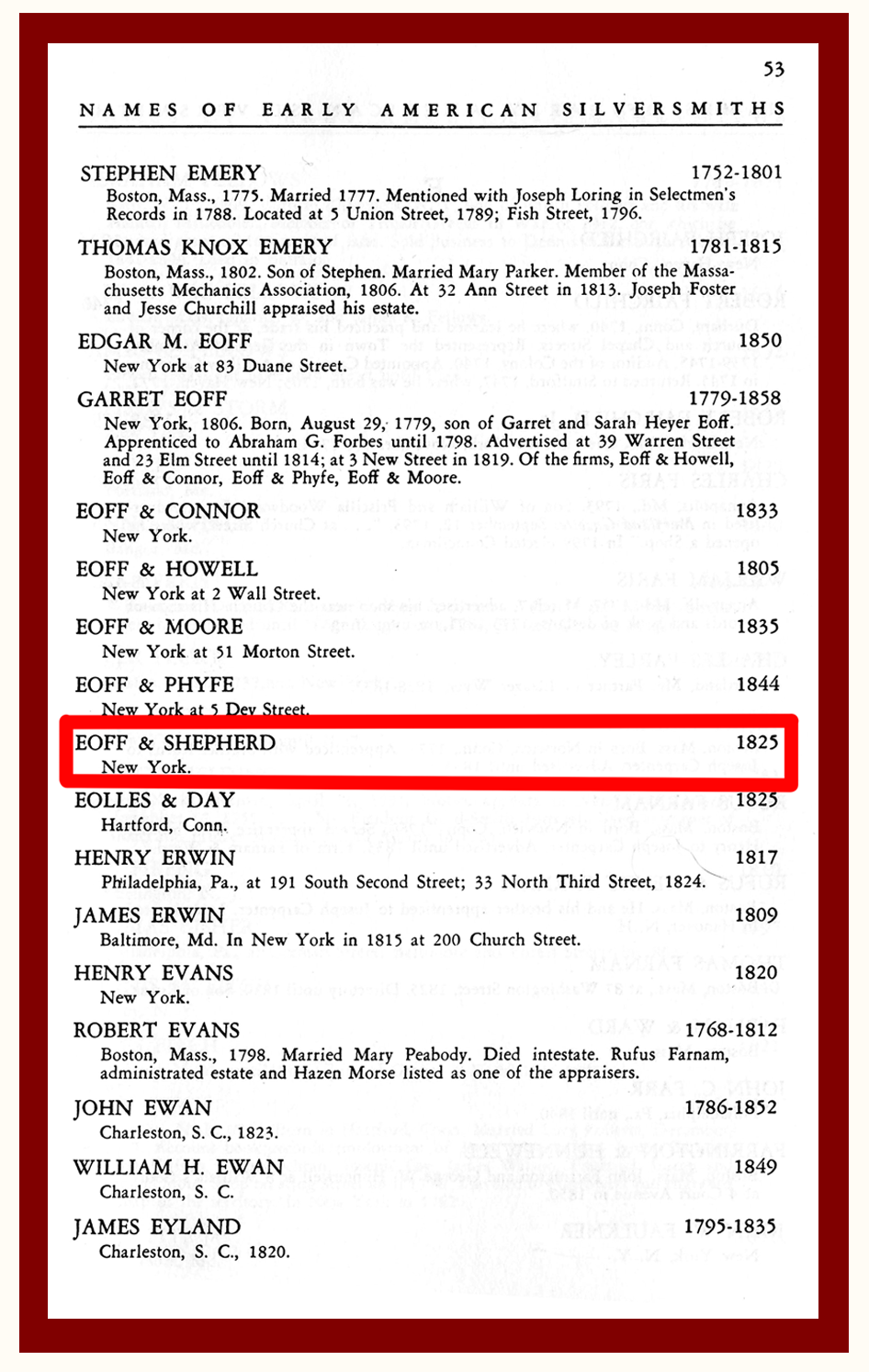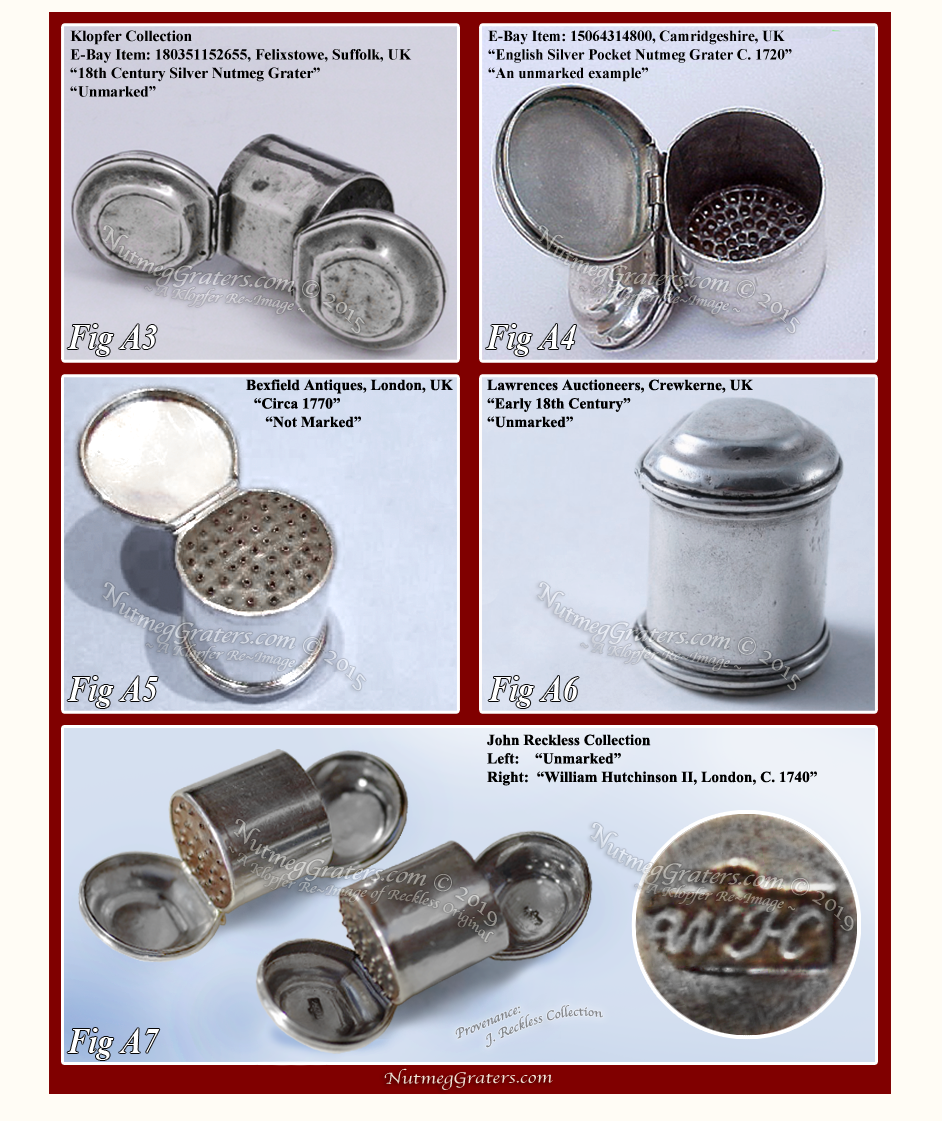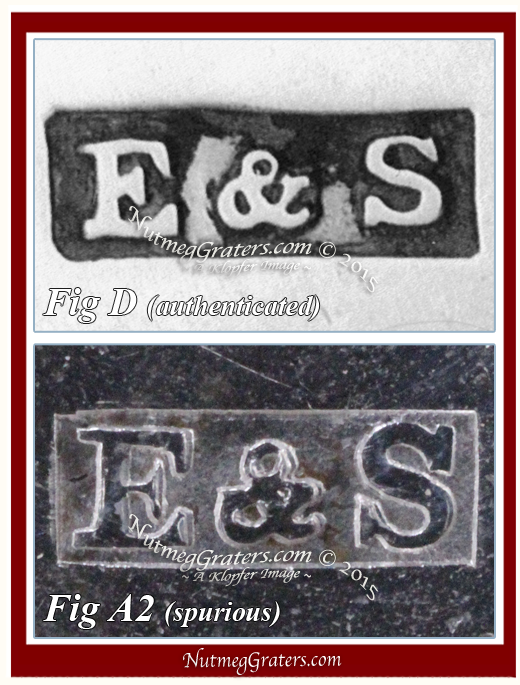NutmegGraters.Com

Investigation Profile # 4. :
Nutmeg graters bearing a maker's marks attributed to silversmiths Eoff & Shepard of New York City began appearing for sale about 2004. Investigation Profile #4 inquires into three of these examples, noting that these nutmeg graters are in forms generally recognized as constructed between Circa 1750 to 1819. Although it was once believed that Eoff & Shepard worked Circa 1825, it is now confirmed that they were actually in business only between 1851/2 to 1860/1861. Regularly, Eoff & Shepard produced silver for and marketed by retailers such as Ball, Black & Company.
Three Pocket Nutmeg Graters Bearing Maker's Marks "E & S": 
Slight variations are expected when comparing the same maker's mark as applied to different silver items [SEE: Below]. The best account for this is detailed in Marks of American Silversmiths in the Ineson-Bissell Collection, Louise Conway Belden, University Press of Virginia, 1980; "Identification of Marks", Pages 21-23. The factors to account for subtle differences between marks struck using the same die include (but are not limited to): silver composition, hardness and quality; "differences in reflect wear, dirt or photographic technique"; the direction of the strike force applied by the silversmith, the amount of strike force; die slippage or lateral movement during the strike, die wear, and/or re-strike (or bounce) of the die. To determine usage of the same die, compare features of spacing, proportions, overall layout, shaping, styling, and most importantly, the identification of unique die flaws and shaping features of lettering and characters. One can observe that (Fig A2) from the flat-sided cylinder silver nutmeg grater (Fig A1), and (Fig B2) from the barrel form silver nutmeg grater (Fig B1), are struck using the same die. No image of the maker's mark is currently available for the egg form silver nutmeg grater (Fig C).

Purchase ~ Background Information:
(Fig A1). A flat-sided cylinder silver nutmeg grater was purchased from Robert Lloyd, Inc, Manhattan Antique Center, New York, New York 10022. The firm described the nutmeg grater as "EXTREMELY RARE........This is an early American coin silver nutmeg grater made in New York City circa 1820 by Eoff & Shepard. This nutmeg came from a collection we bought and have sold some fabulous pieces from. American nutmeg graters are among the rarest form of American silver."
.png) (Original ~ June 2009):
(Original ~ June 2009):
(Fig B1). A barrel form silver nutmeg grater was purchased from S. J. Shrubsole 104 East 57 Street, New York, New York 10022. Posted for sale on the Shrubsole website, Shrubsole describes this item as "An Early American Silver Nutmeg Grater; Maker: Eoff & Shepherd; Place: New York, N.Y. Date: c.1825". Concluding investigation, it was returned for a full refund at which time Shrubsole indicated an earlier provenance to Constantine Gus Kollitus (1934-2013), formerly: 440 West 34th Street, New York, New York 10001.
(Update ~ August 2019):
(Fig B1a). This same barrel form nutmeg grater reappeared, entered at auction by Showplace Antique + Design Center, 40 West 25th Street, New York, NY 10010. The auction house publicized it in their "Fine Silver Collection Part 4 & Other Estates" sale through on-line antiques auction platforms, to include AuctionZip, Invaluable and Bidsquare. All venues, described "Lot 31: E & S silver-Gilt Barrel-Form Nutmeg Grater Box." As "E&S Sterling gilt-silver vermeil nutmeg grater, ribbed barrel-form with screw thread opening to a removable metal rasp, maker's mark: 'E & S' 1.5" H x 1" diameter, approve. 0.37 ozt (weight of rasp not included). Minor dent underside" bearing an "Estimate: $200 - $400".
NutmegGraters.Com notified Showplace Antique + Design Center and its on-line venues prior to the sale date of August 25, 2019 and alerted them to the maker's mark discrepancies and concerns pertaining to the nutmeg grater's history. Showplace Antique + Design Center and their on-line platform services promptly amended their listings, redescribing "Sterling gilt-silver vermeil nutmeg grater, ribbed barrel-form with screw tread opening to a removable metal rasp, spurious maker's mark: 'E&S' 1.5" H x 1" diameter, approve. 0.37 ozt (weight of rasp not included). Minor dent underside." At the auction, the barrel form nutmeg grater sold for $275.
(Update ~ Fall 2019):
(Fig B1b). Based on 3 independent reports by viewers of NutmegGraters.Com, this nutmeg grater was marketed for sale by Robert Lloyd Inc. as the product of "Eoff & Shepard of New York City", and reportedly retailed this grater with a price in the low thousands.
(Update ~ December 2019):
(Fig B1c). An E-Bay seller coded "definitivemanhattan" (including the "Item Location: Chicago, Illinois") auctioned this barrel nutmeg grater. E-Bay Item Number: 133261816624 was described a: "Gold plated, silver antique ribbed nutmeg grater. A finely made gilt / vermeil example of a solid silver antique nutmeg grater plated with a layer of gold inside and out. No hallmark for the year, but done in the telltale style of the late 1700s/ early 1800s when these would have been popular. A makers mark of "E&S" is stamped in the bottom. The two haves thread together and apart cleanly with fine craftsmanship that totally conceals the seam. Opening reveals the fully functioning rasp, that can be removed with a fingernail. This one is a bit smaller sized, allowing it to be carried in a fifth pocket and not take up much space. The nutmeg pictured with it, fits nicely into the compartment for storage. Condition very fine with a few minor dings on the ends. Dimensions are 1 ½" tall and 1" diameter."
Within the e-Bay Ad's description, NutmegGraters.Com noted the absence of any mention that the mark was "spurious". As a condition of sale "definitivemanhattan" listed that the "Seller does not accept returns". This E-Bay sale concluded December 18, 2019 with a single winning bidder at $425.
{NOTICE: The identical "maker's mark" photograph is used in all on-line ads; by both Showplace Antique + Design Center and by "definitivemanhattan".}

(Fig C). The egg form silver nutmeg grater was marketed for sale by Constantine Gus Kollitus, 440 West 34th Street, New York, New York 10001, and offered privately through an e-mailed PDF listings with the description: "Item 4) Eoff & Shepard Circa 1855".
Review of the Literature:
Several recent, and well researched resources clarify that Eoff & Shepard was active "1852-1861" and... "operate[d] a modern steam-powered silverware manufactory that employed twenty-five workers. For nearly a decade, Eoff & Shepard supplied distinctive silverware to prestigious luxury-goods retailers such as Ball, Black & Co." [Silver of the Americas, 1600-2000, American Silver in the Museum of Fine Arts, Boston, Falino and Ward, MFA Publications, Boston, 2008, pages 242-244]. In addition to this excellent documentation, several others current sources indicate that Eoff & Shepard worked only from Circa 1851/2 to 1860/1.
The book American Silversmiths and Their Marks, (1948 {Dover Publication ~1983}Page 53 [See page to the right] ) by Stephen G. C. Ensko, erroneously misattributed the "E&S" maker's mark; inaccurately establishing the company's date of operation as 1825. The Ensko's allocation appears unsupported by research. This error remained unchallenged for decades, and in light of current, historical documentation, it is now confirmed that Eoff & Shepard were actually in operation between "1851/2 to 1860/1" ~ Ensko's "1825" assertion being unfounded and incorrect.
Form and Style:
Compiled for more than 30 years, the Klopfer Image File represents the documentation, study and image collection for more than 3500 silver nutmeg graters: [sources include but are not limited to ~ books and auction catalogs, on-line sales or auction archival resources, private and public collections.] This private file details nutmeg grater form, decorative styles, and marks. This data collection is useful for the processes when making comparative assessments.
(Fig A1, A2~7):These flat-sided cylinder nutmeg grater (Fig A, A3~A6) are rather unique in form. Although this form is absent from the published literature pertaining to silver nutmeg graters, among those shown, one is marked "E&S" (Fig A1~2); another is marked "W*H" (Fig A7 right); and seven unmarked examples are known to this author [five are illustrated here (Fig A3~A7) and two additional examples (not illustrated) are known in private English collections]. All seven have hand punched sheet iron grates, typical of mid to late eighteenth century nutmeg graters. While some have a fixed grate and two hinged covers at either end, others have a single cover at one end with a removable grate beneath the lid. All examples are "plainish" in style, having distinctively "raised" covers. All seven unmarked examples demonstrate an English provenance. This uniquely stylized form is possibly the work of a single, and as yet, unknown silversmith; probably English; possibly the work of William Hutchinson II of London. To date, using both comparative assessment and scientific measurements, no example in this form is authenticated as American in origin.

(Fig B1):
The barrel form silver pocket nutmeg grater (Fig B1~2) is silver guilt. Among the data collection in the Klopfer Image File of Silver Nutmeg Graters, more than 200 examples of barrel form silver pocket nutmeg graters are documented. Among these specimens, the latest authenticated date marked example is confirmed for the year 1819 [SEE: The Robert And Meredith Green Collection of Silver Nutmeg Graters, John D. Davis, The Colonial Williamsburg Foundation, 2002; Pages 26-27]. After 1810, these small barrel form nutmeg graters fell out of style, being replaced by newer designs in nutmeg graters. American silversmiths quickly proceeded with any advances or changes in styles. Regarding the example in question, it might be conceivable that an American barrel example could date as late as the 1820's (the period originally, but now erroneously, claimed by Ensko for the "E&S" maker's mark); but such examples clearly were never produced during the 1850's, when Eoff & Shepard were actually in business. Using both comparative assessment and scientific measurements, no example in this specific small barrel form is authenticated as American in origin.
(Fig C):
The egg form nutmeg grater (Fig C) is an early, "raised by hammering" example. Among the data collection in the Klopfer Image File of Silver Nutmeg Graters, more than 131 examples of egg form silver pocket nutmeg graters are documented. Among these specimens, the latest authenticated date marked example is confirmed for the year 1817 [SEE: NutmegGraters.Com, "How To Date Egg Form Silver Nutmeg Graters" ]. Similar to the barrel form silver nutmeg grater (in question), "raised by hammering" silver egg nutmeg graters were long out of style and lost to advancements in silver technology, when Eoff & Shepard manufactured goods during the 1850's.
An Investigative Portfolio:
MAKER MARK ANALYSIS ~ A Spurious Maker's Mark.
[NOTE: Slight variations are expected when comparing the same maker's mark as applied to different silver items. The best account for this is detailed in Marks of American Silversmiths in the Ineson-Bissell Collection, Louise Conway Belden, University Press of Virginia, 1980; "Identification of Marks", Pages 21-23. The factors to account for subtle differences between marks struck using the same die include (but are not limited to): silver composition, hardness and quality; "differences in reflect wear, dirt or photographic technique"; the direction of the strike force applied by the silversmith, the amount of strike force; die slippage or lateral movement during the strike, die wear, and/or re-strike (or bounce) of the die. To determine usage of the same die, compare features of spacing, proportions, overall layout, shaping, styling, and most importantly, the identification of unique die flaws and shaping features of lettering and characters.]
 [NOTE: Photographing a maker's mark: a Canon MP-E-65 mm lens allows for a super-macro image (extreme close-up) which shows exceptional detail when viewing an original image on a high definition monitor/screen. The detail in images using the Canon MP-E-65 lens captures a high resolution photograph in magnificent quality. For example, this lens captures the image of one third of the tip of a pencil point to yield a high resolution image as large as 40 inches by 40 inches (100 cm X 100 cm). When viewing images throughout this website, keep in mind that by reducing resolution required for an ink-jet printer (at 300 DPI), the image quality is lessoned to only satisfactory image quality, and for a website (at 72 DPI) the image quality details are significantly lessoned to fair or marginal qualities. The actual Direct Visual Comparison between "Marks" was conducted using the highest resolution images available.]
[NOTE: Photographing a maker's mark: a Canon MP-E-65 mm lens allows for a super-macro image (extreme close-up) which shows exceptional detail when viewing an original image on a high definition monitor/screen. The detail in images using the Canon MP-E-65 lens captures a high resolution photograph in magnificent quality. For example, this lens captures the image of one third of the tip of a pencil point to yield a high resolution image as large as 40 inches by 40 inches (100 cm X 100 cm). When viewing images throughout this website, keep in mind that by reducing resolution required for an ink-jet printer (at 300 DPI), the image quality is lessoned to only satisfactory image quality, and for a website (at 72 DPI) the image quality details are significantly lessoned to fair or marginal qualities. The actual Direct Visual Comparison between "Marks" was conducted using the highest resolution images available.]
(I). Direct Visual Comparison of the "Maker's Mark" against authenticated photographic images:
In this investigation, confirmed examples of the Eoff & Shepard, Circa 1850-1860/1 maker's marks were acquired from multiple sources [including Winterthur's Decorative Arts Photographic Collection (DAPC), a collection containing abundant photographic images of American silver and their maker's marks]. Furnished with an authenticated "E&S" maker's mark image by Eoff & Shepard (Fig D), a direct visual comparison was contrasted against the Canon MP-E-65 image of the maker's marks under investigation (Fig A2 and Fig B2).
Using Direct Visual Comparison between high definition images of a spurious vs authenticated maker's marks, significant differences become apparent. Unique features incised into the counterfeit maker's marks, confirm that the same spurious die was used to mark the two silver items in question:
~ (Fig A1~2) the flat-sided cylinder nutmeg grater and
~ (Fig B1~2) the barrel form nutmeg grater.
Notice that within the maker's marks (Fig A2 and Fig B2), the "&" (ampersand) symbol display similarities:
a). There is a telltale spur or raised shoulder (center ~ left side), and
b). it has misshaped"counters"(also called as "bowls").
These clearly indicate that maker's marks (Fig A2 and Fig B2) were struck using the same die.
When compared against the genuine "E&S" maker's marks, as seen in (Fig D), the configurations are dissimilar. The maker's marks neither match in letter proportioning, nor in the quality of die-cutting refinement. The maker's marks (Fig A2 and Fig B2) appear shallow, having edges that appear jagged along the borders, a reflection of the die's poor craftsmanship. Observe that a double-strike (or bounce) occurred when struck by the the silversmith's die (Fig A2). This movement is typical of the work of a crudely skilled and unsophisticated hand. It is conclusive that the maker's marks (Fig A2 and Fig B2) are completely dissimilar to any authenticated "E&S" maker's mark. View the enlarged Image of the spurious mark (Fig A2).
(II). Energy Dispersive X-ray Fluorescence Analysis (ED-XRF):
Dr. Jennifer L. Mass, Ph.D., of Scientific Analysis of Fine Art, LLC and formerly, the Senior Scientist for Winterthur Museum, conducted x-ray fluorescent analysis on this nutmeg grater to measure the presents of its metal elements and the "fineness" of its silver content. "It is thought that the mark might be spurious, and analysis was conducted to determine if the alloy of the piece is period appropriate." Early "silver" [Ag] contained impurities such as "gold" [Au] and "lead" [Pb] which, after 1840 ~ 1860, were fully extracted during the refinement process of silver. Therefore, identifying these impurities indicates that an item's fabrication was prior to this time. Secondly, the degree of "fineness" (or, percentage of silver verses other metals) in antique silver varies among different countries and aides to support knowledge of its place of origin. Two test spots were sampled as follow:
Eoff & Shepard Flat-Sided Cylinder Nutmeg Grater marked "E&S"
[Test Spot #1] (Underside) [Test Spot # 2] (Side)
| ELEMENT | CONCENTRATION |
|---|---|
| Ag La1 | 74.4 wt. % |
| Cu Ka1 | 19.7 |
| Au La1 | 0.16 |
| Pb La1 | 0.40 |
| Ag Ka1 | 79.7 |
| ELEMENT | CONCENTRATION |
|---|---|
| Ag La1 | 72.6 wt. % |
| Cu Ka1 | 20.2 |
| Au La1 | 0.17 |
| Pb La1 | 0.43 |
| Ag Ka1 | 79.1 |
Findings are based on copper [Cu], gold [Au] and lead [Pb] concentrations. Dr. Mass wrote, "This piece has a very low silver concentration, and is period. With this low silver concentration, it cannot be English. Further, the lower silver concentration and the preelectronic silver refining (the presence of trace gold and lead) appear problematic with regard to a high-end silver manufacturing company active c. 1852-1861 in New York City."
Investigation Outcome:
Based on the results from an investigative profile, the three silver pocket nutmeg graters, in question, bear "spurious maker's marks" and thus, are falsely attributed to Eoff & Shepard of New York City (1850~1860/61). Not withstanding the counterfeited maker's mark, all three silver pocket nutmeg graters are genuine eighteenth century antiques, that were originally unmark.
The "fineness" quality with the flat-sided cylinder silver nutmeg grater (Fig A1) is very low and is atypical for English examples. However, based on numerous examples currently seen in the United Kingdom, these are possibly English in origin. More study is necessary to resolve this mystery.
Based on data collection, the barrel form silver nutmeg grater (Fig B1) and egg form silver nutmeg grater (Fig C) are typically English examples, being originally unmarked and the work of unknown silversmiths.
[KLOPFER article © September 2015 { © with updates September 2019, January 2020, & May 2020}]